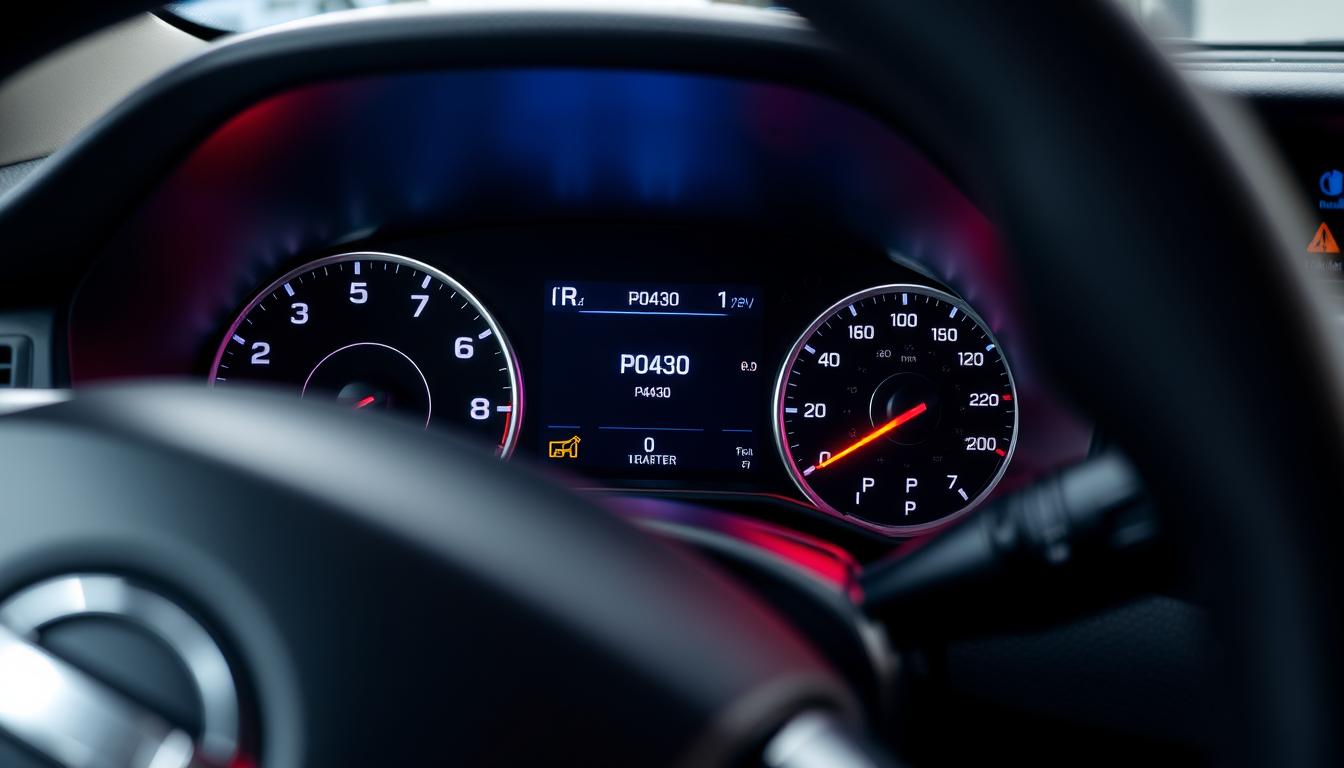The P0430 code is a big problem for Nissan owners. It means there’s an issue with the catalytic converter on the right side of the car. This code tells us the converter isn’t working right, causing pollution. Knowing about the P0430 code is key for Nissan owners to fix their car and keep it running well.
For Nissan owners, the P0430 code is a worry. It can make the car run poorly and cost a lot to fix. Catalytic converters can cost between $110 and $1,000. The total cost to replace them can be from $400 to over $2,000. It’s important to fix the P0430 code to keep the car in good shape and avoid more damage.
Key Takeaways
- The P0430 code indicates a problem with the catalytic converter on the right bank of Nissan vehicles.
- Understanding the P0430 code is essential for Nissan owners to address issues related to catalytic system efficiency.
- A P0430 code fix can be complex, but recognizing signs and symptoms is the first step towards resolving the problem.
- The cost of catalytic converters and replacement can be significant, ranging from $110 to $1,000 and $400 to $2,000, respectively.
- Addressing the P0430 code Nissan is crucial for maintaining vehicle health and avoiding further damage.
- Nissan owners should be aware of the potential consequences of ignoring the P0430 code and seek professional help if necessary.
- A suitable P0430 code fix can help prevent further damage and ensure the vehicle runs smoothly.
Understanding the P0430 Code Nissan Catalyst System Error
The P0430 code is a common issue for many Nissan owners. It shows that the catalyst system on Bank 2 isn’t working right. This can cause more emissions and performance issues if not fixed quickly.
What Does P0430 Mean?
The P0430 code means the catalytic converter on Bank 2 isn’t doing its job. It’s not cutting down harmful emissions as it should. When it notices this, it sends out the P0430 error to let the driver know.
Why This Code Appears in Nissan Vehicles
Nissan cars have special emission controls that depend on the catalytic converter. Problems like engine misfires, bad oxygen sensors, or leaks can lower the system’s efficiency. This leads to the P0430 code.
Impact on Vehicle Performance
With the P0430 code, you might see a rough idle or less fuel efficiency. Drivability issues might not be obvious, but ignoring this warning can cause bigger engine problems. It can also lead to higher emissions, harming both your car and the environment.
| Symptom | Possible Cause | Solution |
|---|---|---|
| Rough Idle | Faulty Oxygen Sensor | Replace the oxygen sensor with OEM parts |
| Decreased Fuel Efficiency | Exhaust Leak | Inspect and repair any exhaust leaks |
| Check Engine Light | Worn Catalytic Converter | Replace the catalytic converter |
Common Symptoms Associated with Code P0430
It’s important to know the signs of a P0430 code diagnosis Nissan to keep your car in good shape. A big sign is the check engine light coming on. This light means your Nissan needs some attention.
You might also notice your engine running rough or feeling weak. This can make driving less smooth. Also, you might see your car using more gas than usual, which can cost more.
Some owners of the 2011 SL AWD Nissan Murano have had trouble. They’ve tried replacing oxygen sensors and catalytic converters but it didn’t fix everything. But, a full tune-up often helps in 80% of cases.
- Check engine light activation
- Rough or unsteady engine performance
- Significant decrease in fuel efficiency
- Unusual smells from the exhaust, such as a rotten egg odor
- Failed emissions tests
| Symptom | Possible Cause |
|---|---|
| Check Engine Light | Faulty oxygen sensors or catalytic converter issues |
| Rough Engine | Engine misfires or exhaust leaks |
| Poor Fuel Economy | Clogged catalytic converter or inefficient fuel injectors |
| Rotten Egg Smell | Failing catalytic converter |
| Failed Emissions Test | Inefficient catalytic converter or faulty sensors |
Primary Causes of P0430 in Nissan Vehicles
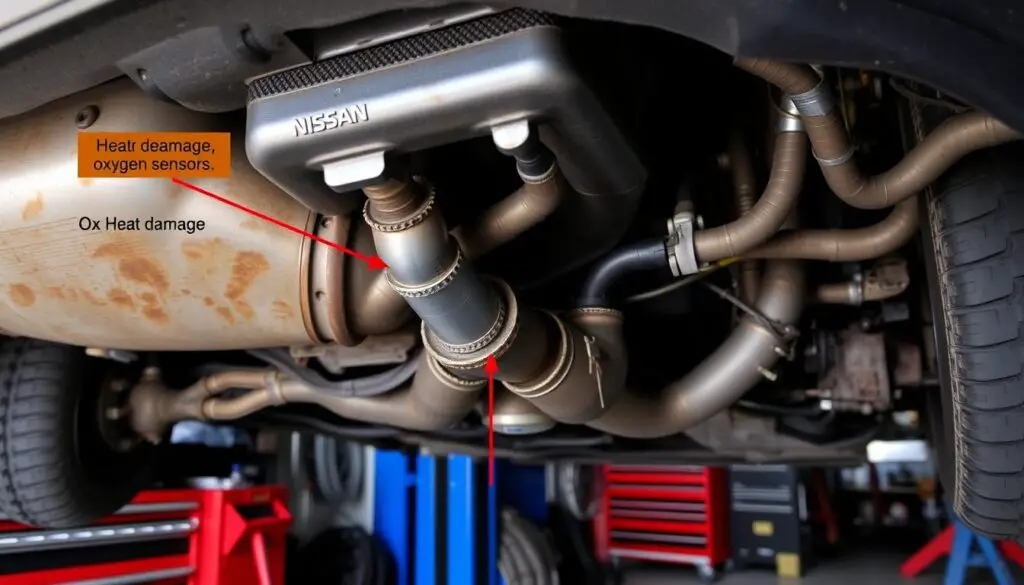
The P0430 code in Nissan vehicles shows problems in the catalytic system. Knowing the main causes helps in finding and fixing the issue.
Catalytic Converter Degradation
A worn-out catalytic converter can’t handle exhaust gases well. Dirt and too much heat make it clog, leading to the P0430 code.
Oxygen Sensor Issues
Bad oxygen sensors can’t track oxygen levels right. This mistake messes up fuel mix, making the engine work too hard and causing the P0430 code.
Exhaust System Leaks
Leaks in the exhaust system let extra oxygen in. This messes up the balance needed for the catalytic converter to work. These leaks can come from broken pipes or bad connections, causing the P0430 code.
Engine Performance Problems
Engine problems like misfires and poor performance let unburned fuel reach the catalytic converter. This damage over time leads to the P0430 code.
Diagnostic Methods for P0430 Code
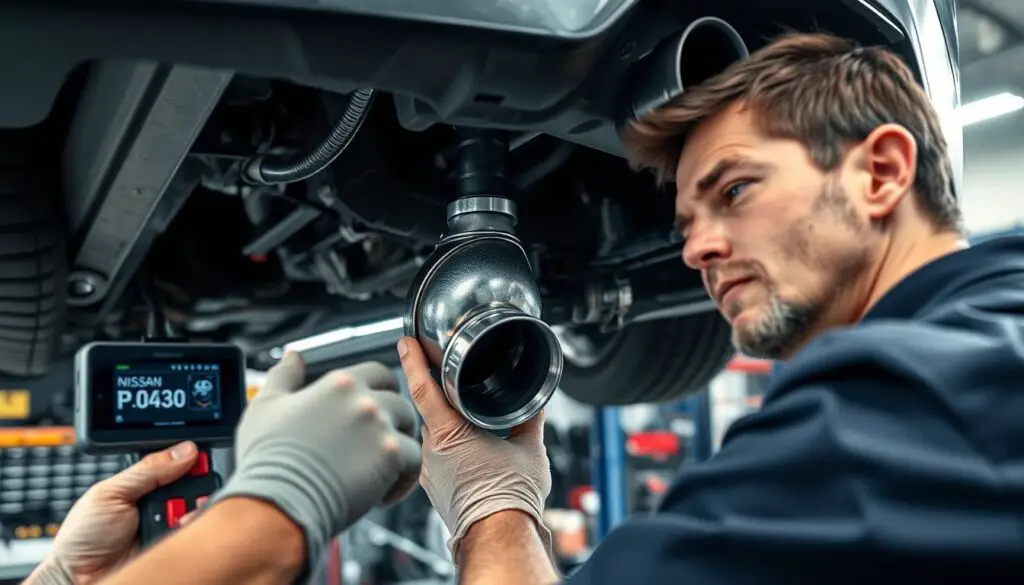
Accurately diagnosing a P0430 code Nissan is key to keeping your car running well. Begin by using an OBD-II scanner. It helps you get the specific error code and some initial data.
Then, check the exhaust system for leaks. Even small leaks can mess with sensor readings and engine performance.
Testing the oxygen sensors is also crucial. Bad sensors can give wrong readings on oxygen levels in exhaust gases. This can lead to the P0430 code being triggered.
Don’t miss mechanical issues like leaking fuel injectors or head gaskets. Also, be careful not to misread sensor data. Correct diagnosis prevents unnecessary repairs and makes sure the right parts are fixed.
| Diagnostic Method | Estimated Cost | Details |
|---|---|---|
| OBD-II Scanner | $90 | Initial code retrieval and data analysis. |
| Exhaust Leak Inspection | $50 | Visual and auditory inspection for leaks. |
| Oxygen Sensor Testing | $154.99 | Assessing sensor functionality and readings. |
Model-Specific P0430 Issues in Nissan Altima
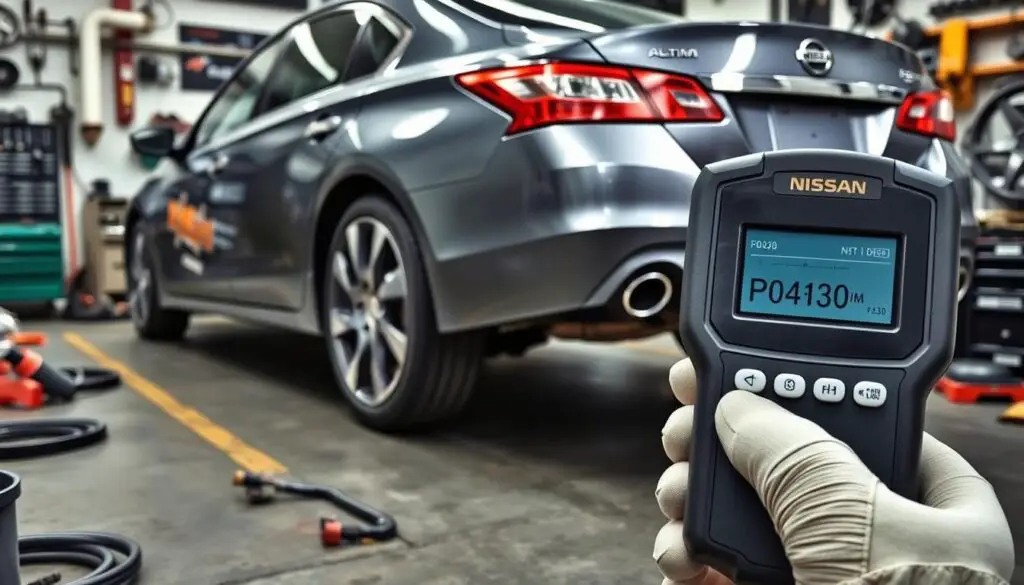
Nissan Altima owners might see the P0430 code, which means there’s a problem with the catalytic system. Knowing about these specific issues can help fix problems quickly and keep the car running well.
Common Failure Points
The P0430 code usually means trouble with the catalytic converter or oxygen sensors. These parts are key for controlling emissions and keeping the engine running smoothly.
Model Year Variations
Older Nissan Altima models, like those from the mid-2000s, often face P0430 problems. Newer models have better fuel management software, which helps the catalytic converter last longer.
Technical Service Bulletins
Nissan has issued technical service bulletins for the P0430 code in Altima models. These bulletins offer tips for finding and fixing the issues in affected cars.
| Repair Component | DIY Cost | Mechanic Cost |
|---|---|---|
| Spark Plugs | $83-$112 | $212-$276 |
| Spark Plug Wires | $66-$84 | $208-$256 |
| Damaged Wiring | $25-$100 | $100-$350 |
| Exhaust Leak Repair | N/A | $100-$200 |
| Oxygen Sensor | $300-$333 | $362-$412 |
| Catalytic Converter | $2,153-$2,254 | $2,304-$2,443 |
P0430 Troubleshooting in Nissan Pathfinder
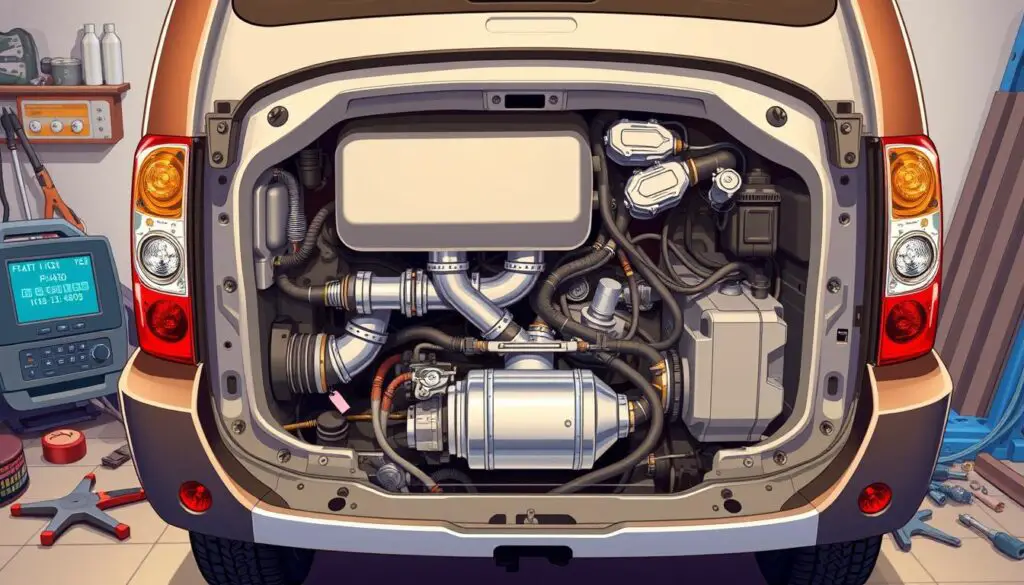
The P0430 Nissan Pathfinder code means there’s a problem with the catalytic converter on bank 2. This can lead to less fuel economy and engine issues. Nissan Pathfinder owners might notice these problems when this code pops up.
Causes of the P0430 Nissan Pathfinder code include worn-out catalytic converters, faulty oxygen sensors, and leaks in the exhaust system. For example, a 2005 Nissan Pathfinder with 97,000 miles changed from a P0174 code to P0430 after fixing the front air/fuel sensor on bank 2.
To fix the P0430 Nissan Pathfinder code, do the following:
- Look for damage or wear on the catalytic converter.
- Check the oxygen sensors to see if they’re working right and replace them if not.
- Search for leaks in the exhaust system that could mess up sensor readings.
- Do a full tune-up to make sure everything in the engine is working well.
Using Cataclean can help clean the catalytic converter and might get rid of the P0430 code. It’s also key to make sure O2 sensors are accurate. Wrong readings can confuse the ECU and harm the catalytic system more.
Fixing the P0430 Nissan Pathfinder can cost different amounts. Nissan does inspections for about $90. Replacing a catalytic converter from Infiniti might cost around $1,300. Using OEM parts is best to keep the system working right and avoid needing to replace sensors often.
Keeping up with regular maintenance and replacing sensors on time can stop the P0430 Nissan Pathfinder code from coming back. This makes sure your car runs well and efficiently.
Understanding P0430 in Nissan Murano Models
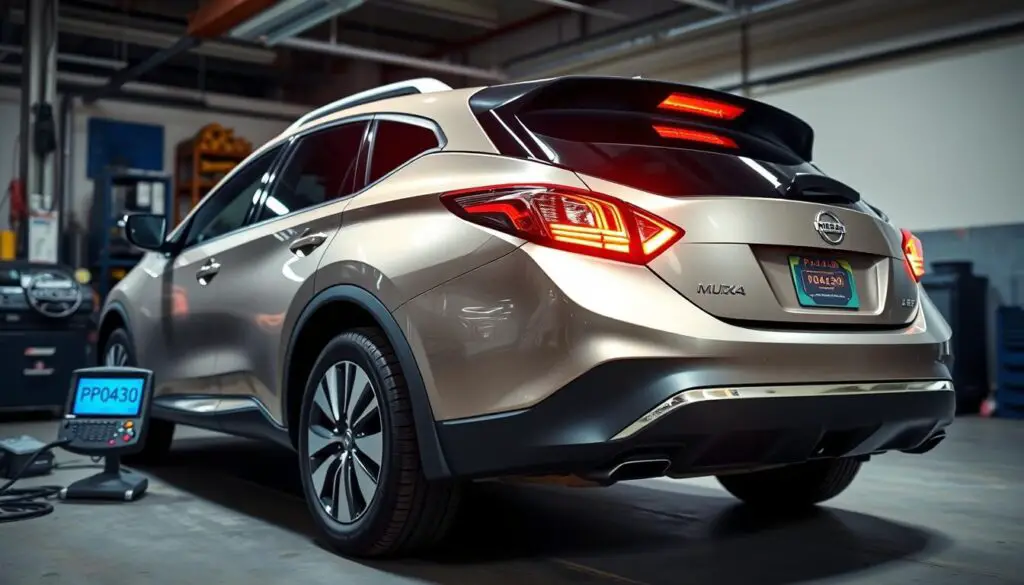
The P0430 code in Nissan Murano models means there’s a problem with the catalytic converter’s efficiency. This warning tells owners about issues that can harm performance and emissions.
Known Issues
In Nissan Murano models, the P0430 code usually points to a bad catalytic converter. Other common problems include vacuum leaks and engine damage like a leaking head gasket. Also, issues with the Powertrain Control Module (PCM) and camshaft variable timing solenoids are common causes.
Repair Patterns
Fixing the P0430 code in a Nissan Murano involves several steps. Many owners find that using OEM oxygen sensors works better than aftermarket ones. A full tune-up, as advised by muffler shop experts, can often fix the problem.
It’s also important to fix vacuum leaks and make sure the Mass Air Flow (MAF) sensor works right. Cleaning the MAF sensor might help, but replacing it with an OEM one usually keeps the car running smoothly without more catalytic converter codes.
DIY Diagnostic Steps for P0430
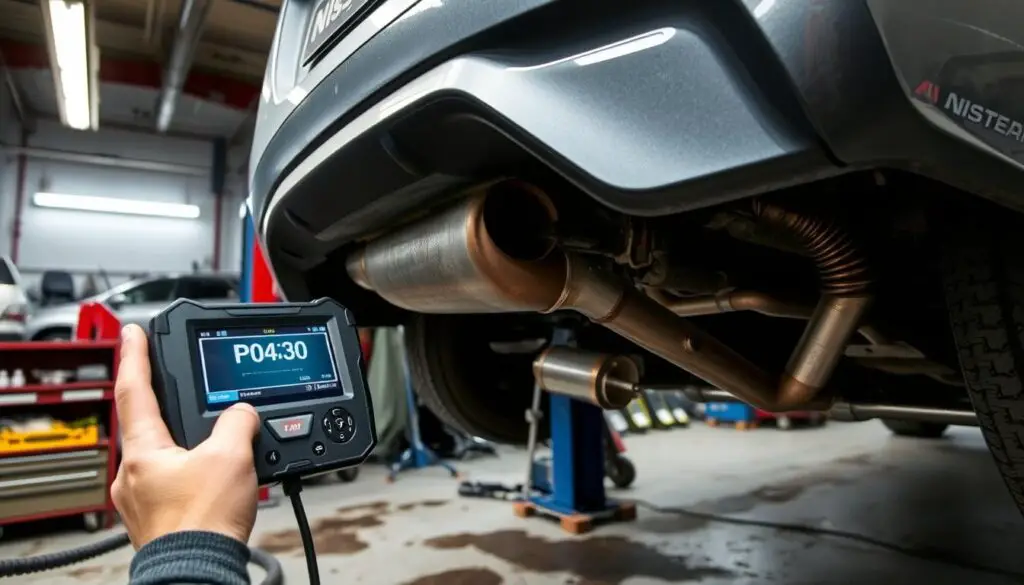
If your Nissan shows the P0430 code, you can fix it yourself. Just follow these steps. This way, you can save money and time. But, always keep safety first.
Required Tools
- OBD-II scanner
- Multimeter
- Basic hand tools (wrenches, screwdrivers)
- Flashlight
Safety Precautions
- Make sure the car is parked on a flat surface and the engine is off
- Wear protective gloves and eyewear
- Turn off the battery before working on electrical parts
- Stay away from exhaust fumes
Step-by-Step Process
- Plug in the OBD-II scanner to the car’s diagnostic port and get the P0430 code.
- Look for any leaks or damage in the exhaust system.
- Use a multimeter to check the upstream and downstream oxygen sensors. Make sure they work right.
- Look for signs of catalytic converter wear or contamination.
- Clear the error code and drive the car to see if the code comes back.
By following these steps, you can fix the P0430 code well. For more help, check your car’s service manual or talk to a professional.
Professional Repair Options and Costs
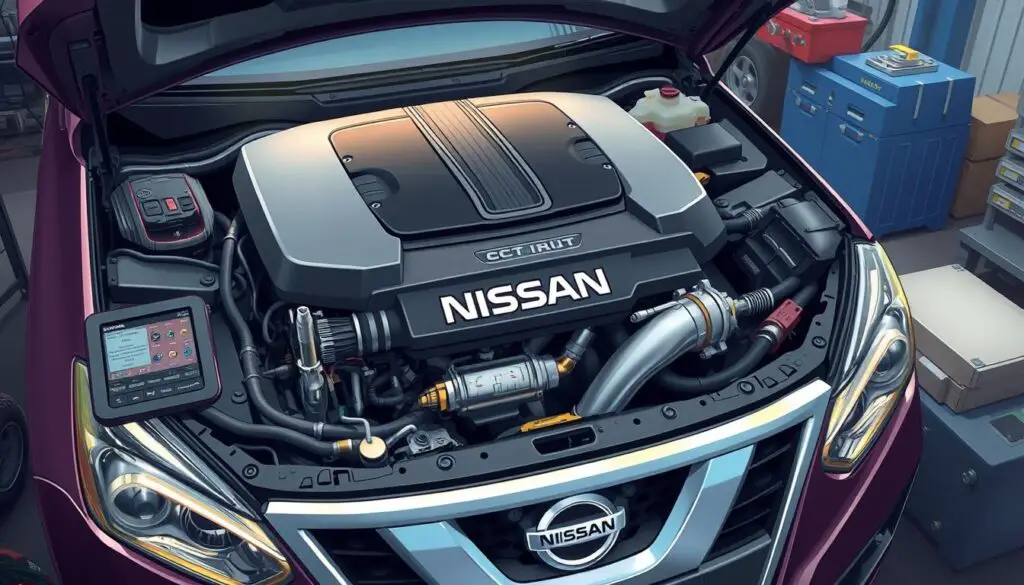
Fixing the P0430 code in your Nissan needs a pro to keep your car running right. Costs can be from $400 to $2,000. This depends on the problem and your Nissan’s model.
Several things affect the price. These include how bad the catalytic converter is, if oxygen sensors need replacing, and if the exhaust system needs fixing.
- Expert diagnosis finds the exact problem.
- Using good parts means your car lasts longer and works better.
- Having a pro install it lowers the chance of more car troubles.
| Repair Option | Cost (DIY) | Cost (Mechanic) |
|---|---|---|
| Spark Plugs | $83–$112 | $212–$276 |
| Oxygen Sensor | $300–$333 | $362–$412 |
| Catalytic Converter | $2,153–$2,254 | $2,304–$2,443 |
When picking a mechanic, go for someone who knows Nissan cars well. They’ll fix the P0430 code right. Good repairs fix the problem and make your car better and last longer.
Catalytic Converter Replacement Guidelines
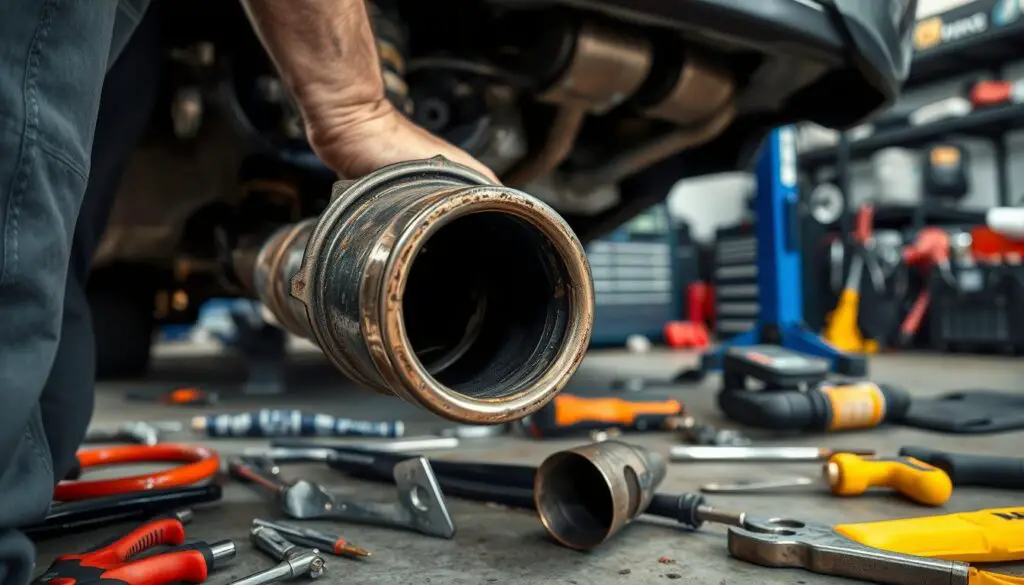
Fixing a P0430 code means you need to think about replacing the catalytic converter. It’s important to pick the right parts for good performance and to follow emission rules.
OEM vs Aftermarket Options
Choosing between OEM and aftermarket catalytic converters is a big decision. Here’s what you need to know:
- OEM Catalytic Converters: Made by the car maker, they fit perfectly and work well. They usually come with a warranty but cost more.
- Aftermarket Catalytic Converters: These are cheaper and come in many types. But, their quality can be different, and they might not meet all emission rules.
Installation Considerations
Installing the converter right is key for fixing the P0430 code. Here are important things to remember:
- Quality of Parts: Choose high-quality OEM parts for the best performance and to last longer.
- Professional Installation: A skilled mechanic can avoid mistakes that could cause more problems.
- Compatibility: Make sure the new catalytic converter fits your Nissan model.
| Option | Cost Range | Quality | Warranty |
|---|---|---|---|
| OEM Catalytic Converter | $500 – $1,000+ | High | Manufacturer-backed |
| Aftermarket Catalytic Converter | $110 – $700 | Variable | Limited to none |
Preventing Future P0430 Codes
Keeping your Nissan in top shape is crucial to avoid the P0430 code. Regular maintenance helps your car run well and efficiently.
Maintenance Tips
- Regular Spark Plug Replacements: Replace spark plugs as recommended to prevent engine misfires that can trigger the P0430 code Nissan.
- Timely Oxygen Sensor Replacement: Faulty oxygen sensors can cause inaccurate readings, leading to catalyst system errors.
- Inspect the Exhaust System: Check for leaks or blockages regularly to maintain optimal performance and prevent P0430 issues.
- Use Quality Fuel: Opt for high-quality fuel to avoid contaminants that can damage the catalytic converter.
- Monitor Engine Performance: Address any engine performance problems promptly to reduce the risk of triggering the P0430 code.
Warning Signs
Knowing the early signs can help you fix problems before they get worse. Look out for a lit check engine light, lower fuel efficiency, or a bad smell from the exhaust. These signs mean your Nissan might be getting a P0430 code, so act fast.
By following these maintenance tips, you can avoid the P0430 code and keep your catalytic converter and other parts in good shape. Regular care means better performance, better fuel use, and a safer drive.
Legal and Emissions Considerations
Keeping your Nissan P0430 catalyst system efficient is key for the environment and the law.
Since 1975, cars must have catalytic converters to cut down on harmful emissions. A bad catalytic converter, shown by the P0430 code, means more pollutants in the air.
Important things to think about include:
- Emissions Standards: The Environmental Protection Agency (EPA) has strict rules for emissions.
- State Inspections: Many states require emissions tests for car registration.
- Legal Penalties: Driving with a broken catalytic converter can lead to fines or failing inspections.
| Aspect | Impact |
|---|---|
| Nissan P0430 Code | Shows the catalyst system isn’t working right. |
| Emissions Levels | More pollutants because the converter isn’t working well. |
| Legal Compliance | Could fail to meet EPA emission standards. |
| Vehicle Inspection | May not pass state emissions tests. |
Ignoring the P0430 code harms the environment and can lead to legal trouble and expensive fixes. Making sure your catalytic converter works well keeps you in line with emissions rules and helps the planet.
When to Seek Professional Help
Finding a P0430 code in your Nissan can worry you. Knowing when to get help keeps your car running well.
Warning Signs
- Check Engine Light is illuminated
- Decreased fuel efficiency
- Strange noises from the exhaust system
- Failed emissions tests
Choosing a Qualified Mechanic
- Look for certifications like ASE (Automotive Service Excellence)
- Read reviews and seek recommendations
- Ensure the mechanic has experience with Nissan vehicles
- Ask about diagnostic tools and technologies they use
Getting a skilled mechanic to fix a P0430 code in your Nissan quickly is key. It stops bigger problems and saves you money later.
Understanding Warranty Coverage for P0430 Repairs
Dealing with the P0430 code Nissan can be stressful, mainly because of the repair costs. It’s key to know your vehicle’s warranty to handle these costs well.
Nissan warranties usually cover the catalytic converter and related parts for a certain time or mileage. The emissions warranty often covers these parts for up to 8 years or 80,000 miles, based on your car model.
- Coverage Includes: Catalytic converter, oxygen sensors, and exhaust system components.
- Exclusions: Damage from accidents, wrong maintenance, or aftermarket changes.
To see if your P0430 code Nissan repair is covered, check your warranty booklet or talk to your Nissan dealer. It’s vital to act fast, as late claims might not be accepted.
“Knowing your warranty can save you thousands in repair costs and keep your vehicle running well,” says automotive expert Jane Smith.
When you file a warranty claim, give all needed documents, like diagnostic reports and service records. This makes the claims process easier and boosts your chances of getting coverage.
| Repair Component | Typical Warranty Coverage | Average Cost Without Warranty |
|---|---|---|
| Catalytic Converter | 8 years / 80,000 miles | $2,000+ |
| Oxygen Sensors | 5 years / 60,000 miles | $150 – $500 |
| Exhaust System | 5 years / 60,000 miles | Varies |
Knowing about your warranty coverage makes fixing the P0430 code Nissan both quick and affordable. It protects your vehicle’s performance and life span.
Long-term Impact of Ignoring P0430
Ignoring the P0430 Nissan Sentra code can cause big problems for your car. One major issue is less fuel efficiency. If the catalytic converter isn’t working right, your engine uses more fuel to keep running well.
Another big problem is your car’s performance will suffer. You might notice it’s slower to accelerate and has less power. These problems can wear down other engine parts, leading to even bigger and more expensive repairs.
Not fixing the P0430 code can also damage the catalytic converter. Running with a bad system can make it overheat and fail. Replacing it can cost up to $1000 or more, depending on your car and any extra damage.
Also, ignoring the P0430 code can make your car pollute more. This can cause it to fail emissions tests. Keeping your car in good shape saves money on fuel, improves performance, and avoids costly repairs later on.
| Potential Consequences | Description | Estimated Cost |
|---|---|---|
| Decreased Fuel Efficiency | Increased fuel consumption due to engine strain. | Variable |
| Reduced Engine Performance | Sluggish acceleration and diminished power. | Minor Repairs to Major Engine Components |
| Catalytic Converter Damage | Overheating and failure of the catalytic converter. | Up to $1000+ |
| Increased Emissions | Higher levels of pollutants released into the environment. | Potential Failing Emissions Tests |
| Additional Engine Damage | Strain on other components leading to costly repairs. | Variable |
Conclusion
Fixing the P0430 code Nissan is key to keeping your car in top shape. If you ignore this code, it could cause more harm and cost a lot more, up to $3,000 USD.
Regular checks on oxygen sensors and the catalytic converter can stop the P0430 code. Using OEM parts, like NGK sensors, makes your Nissan’s emission system work better and last longer.
Acting fast to diagnose and fix the P0430 code can save you money and keep your car running for years. Always watch how your car is doing and get help from a mechanic if you need to. This way, your Nissan will stay in great condition.
FAQ
What is the P0430 code in Nissan vehicles?
What does “Nissan P0430 catalyst system efficiency below threshold” mean?
What are the common causes of the P0430 code in Nissan Altima?
How can I fix the P0430 code in my Nissan Pathfinder?
What symptoms indicate a P0430 code in a Nissan Murano?
How is the P0430 code diagnosed in a Nissan Sentra?
Can I perform a DIY diagnostic for the P0430 code in my Nissan?
What are the professional repair options for the P0430 code in Nissan vehicles?
Should I use OEM or aftermarket catalytic converters for my Nissan’s P0430 code fix?
What preventive measures can I take to avoid future P0430 codes in my Nissan?
What are the legal and emissions-related implications of a P0430 code in Nissan vehicles?
When should I seek professional help for a P0430 code in my Nissan?
Does my Nissan warranty cover repairs for the P0430 code?
What are the long-term consequences of ignoring a P0430 code in a Nissan Sentra?
How does a faulty catalytic converter affect my Nissan’s performance?
Are there any model-specific technical service bulletins for the P0430 code in Nissan Altima?
Can exhaust system leaks trigger a P0430 code in Nissan vehicles?

Jack Thompson is a writer and seasoned auto mechanic with over 15 years of experience in the automotive industry. Known for his expertise in vehicle mechanics, Jack has a deep understanding of car and truck systems. His skills, honed through years of hands-on experience, have made him a trusted name in the field. Jack is committed to providing valuable insights into car maintenance and repair, helping vehicle owners keep their vehicles in top condition.

